Unless you live in the tropics, there’s no way to grow tomatoes outdoors in the winter. In some areas, you may be able to start plants in early spring or keep your plants fruiting into the fall, but generally, tomatoes won’t survive the first frost.
If you can’t survive another winter without fresh tomatoes, and you can’t stand the bland, watery, underripe so-called “tomatoes” available at the grocery store, your final resort may be to try growing them indoors. In all honesty, this is not an enterprise for busy, distracted gardeners. It requires a suitable space, an investment in supplies and equipment, and plenty of time to commit to maintaining the plants.
If none of that worries you, and you’re ready to embrace the challenge of growing tomatoes indoors, read on.
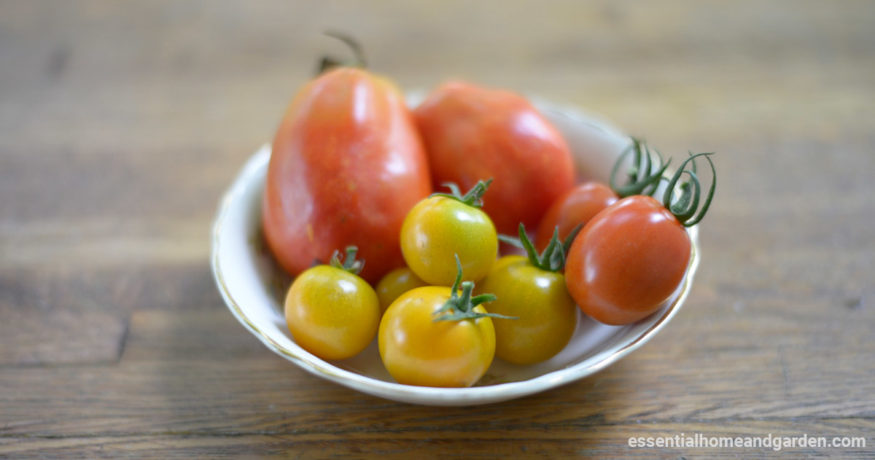
Can You Grow Tomatoes Indoors?
Yes, absolutely. A tomato plant does not know whether it is growing indoors or outdoors or in a greenhouse. What a tomato plant knows, and responds to, is whether or not it is having its needs met.
It is possible, albeit somewhat difficult, to give an indoor tomato plant what it needs to be healthy and productive.
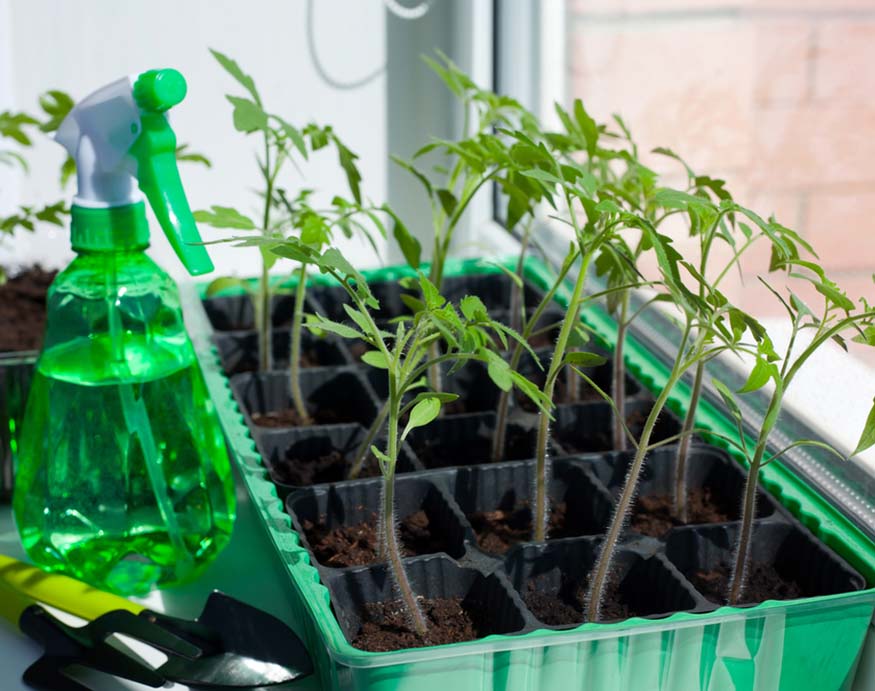
So what does a tomato plant need?
- Fresh circulating air
- Warm temperatures
- Water
- Lots of light (both warm and cool tone)
- A suitable container to grow in
- Growing medium (this can be soil or, in the case of hydroponics, water)
- Fertilizer
- Physical support for branches
With these key ingredients (plus the tomato seeds or seedlings), you can grow this tasty vegetable indoors.
Read more: How to start seeds in a greenhouse
How To Grow Tomatoes Indoors
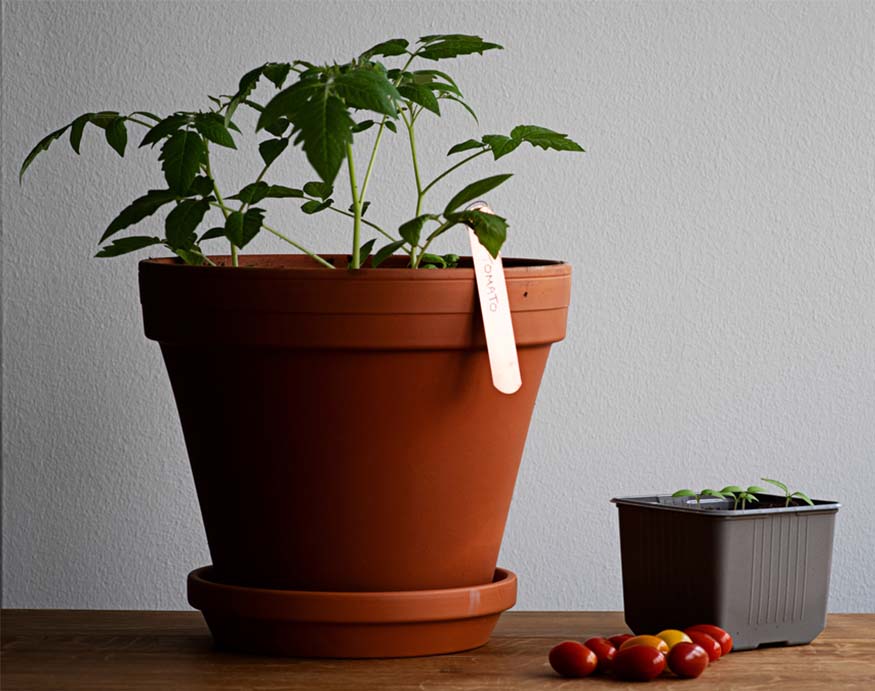
1. Set Up the Growing Environment
You have a few options for creating an indoor environment suitable for growing tomato plants in most growing zones. You need to consider light, air circulation, and temperature. You should keep tomato plants between 60°-90° Fahrenheit — their preferred range is 72°-82° F.
Our guide is focused on plants potted in soil, but most of this guide applies equally to plants grown hydroponically.
Some of your options for setting up a growing environment for your tomatoes are:
Setting Up In a Greenhouse
During winter, you can grow tomato plants in a heated greenhouse. Grow them in pots rather than directly in the soil under the greenhouse, because they will freeze when the ground freezes.
If you have an unheated greenhouse you should add grow lights for supplemental light, to make up for the shorter and weaker winter sunlight.
Setting Up Near a Window
You don’t need a greenhouse to grow tomatoes in winter. Growing tomatoes in a well-lit, south-facing window, ideally in a room with east and/or west-facing windows, is also a good option. However, even the brightest window will not provide optimal light — you will need to use grow lights for supplemental light.
Temperature is another challenge in setting up tomatoes in a window. Use a thermometer to take a temperature reading next to the window. Unless you have very well-insulated windows, it will often be cooler there than in the location where your home thermostat takes its reading.
Remember, You should keep tomato plants between 60°-90° Fahrenheit — their preferred range is 72°-82° F.
Setting Up A Grow Room
You can use a small room (or a tent) when growing tomatoes indoors. Cover the walls of the room in reflective sheeting and install grow lights. If you are growing micro tomato plants, you may want shelves or tables. For taller tomato varieties, you might place the pots directly on the floor.
In a grow room, like a greenhouse, you need to pay attention to air circulation. Plants consume CO2 and release moisture and grow lights produce heat. Use an extractor fan to draw the humid, CO2-depleted air out, and use an intake fan to replace it with dry, CO2-rich air from outside the room.
Here’s an example of a simple indoor tomato setup:
2. Choose a Grow Light
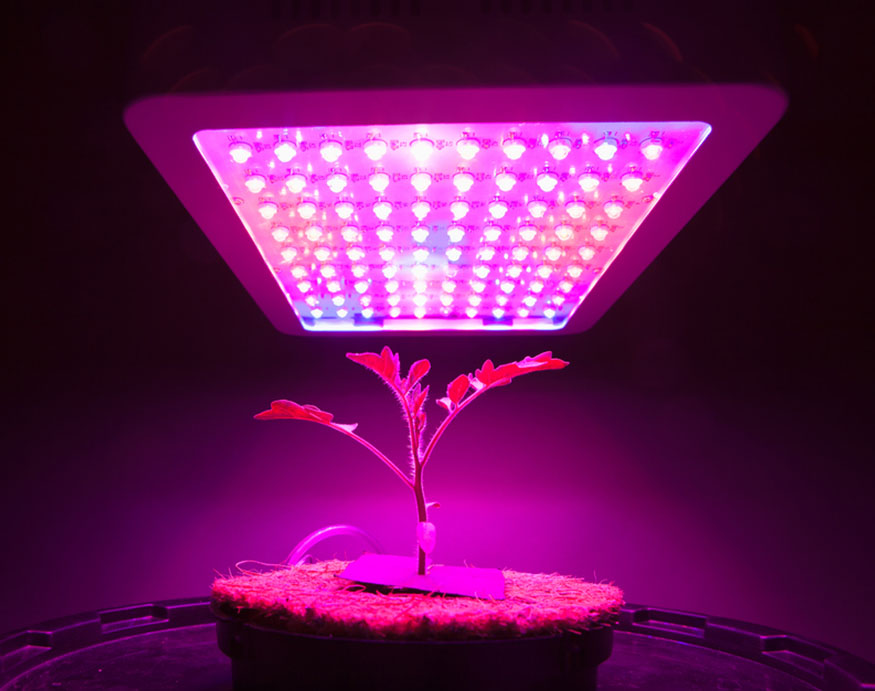
You will find grow lights that can emit blue or red/pink color. That is because different parts of the light spectrum are beneficial for different purposes.
Blue light promotes thick vegetative growth, while warm-toned lights promote flowering. If you’re growing houseplants you might only want one or the other. But when growing tomatoes indoors, you’ll need blue and warm-tone grow lights to encourage healthy vegetation and flowering.
For example, if you’re setting up a grow room you could use a few of these lights, enough to fill the space. Alternatively, this inexpensive option would work well to supplement tomatoes growing in a south-facing window.
Check out this video for a more in-depth guide on choosing and using grow lights:
3. Start Tomato Seeds Indoors
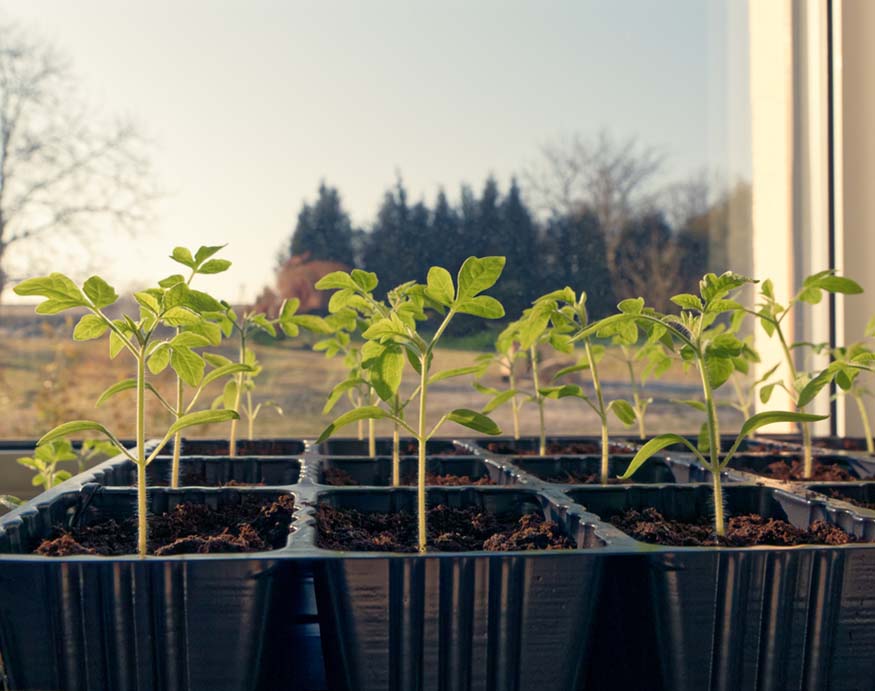
You can start with purchased tomato seedlings or start your own seeds.
Sow tomato seeds in multi-cell seed starting trays and use a soilless seed starting mix. Do not fertilize.
Water and cover with a clear plastic dome to retain heat and humidity, and place the trays under your grow lights. Keep them consistently damp to get a good germination rate.
When the sprouts are nearly touching the dome, remove them. When the seedlings are sturdy, and the roots are coming out the bottom of the trays, it’s time to repot using regular potting mix (not garden soil). You may find that it works best to lighten up your potting mix by adding some coconut coir or peat moss.
Make sure you use an appropriate size of pot for your tomato. Dwarf plants might be fine with a pot only six inches across, but an indeterminate tomato will want a large, deep pot.
Pollinating Tomatoes Indoors
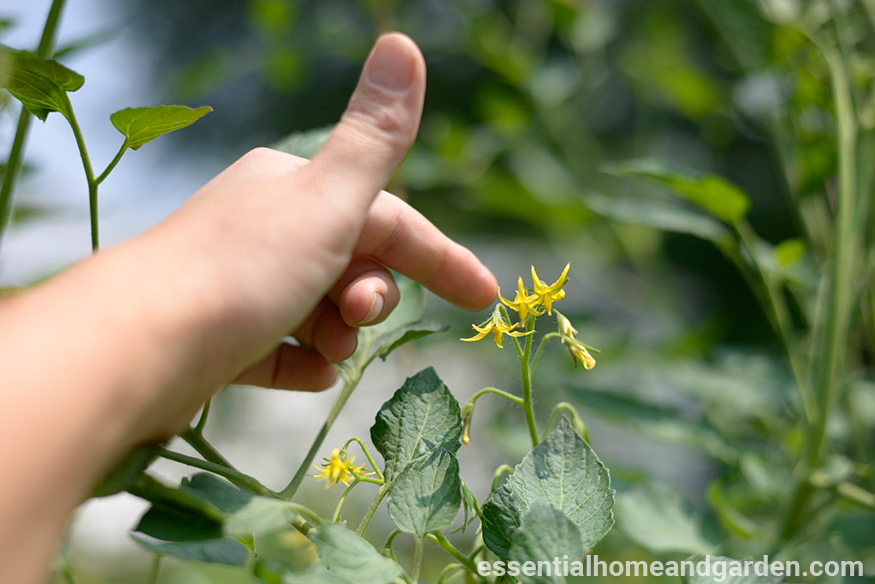
Tomato plants are self-fertile, meaning that they have both female and male parts in the same plant (unlike plants like squash that produce both male and separate female flowers). However, tomatoes do not self-pollinate; they need assistance moving the pollen from the anther to the stigma.
Your best bet is to imitate nature. Aim a gentle oscillating fan at your plants or manually jiggle the flower stems (be gentle so you don’t break off any blossoms). This will mimic the effect of a breeze. Another option is to use the back of the head of an electric toothbrush to shake the flowers gently, like a bee’s wings.
Some people recommend using a small paintbrush or a q-tip to mimic a bee’s fuzzy butt and transfer the pollen directly. However, this method is usually less successful because the flower structure makes accessing the pollen difficult.
Learn more: The Best Greenhouse Vegetables
Care and Maintenance of Your Indoor Tomatoes
Watering and Fertilizing
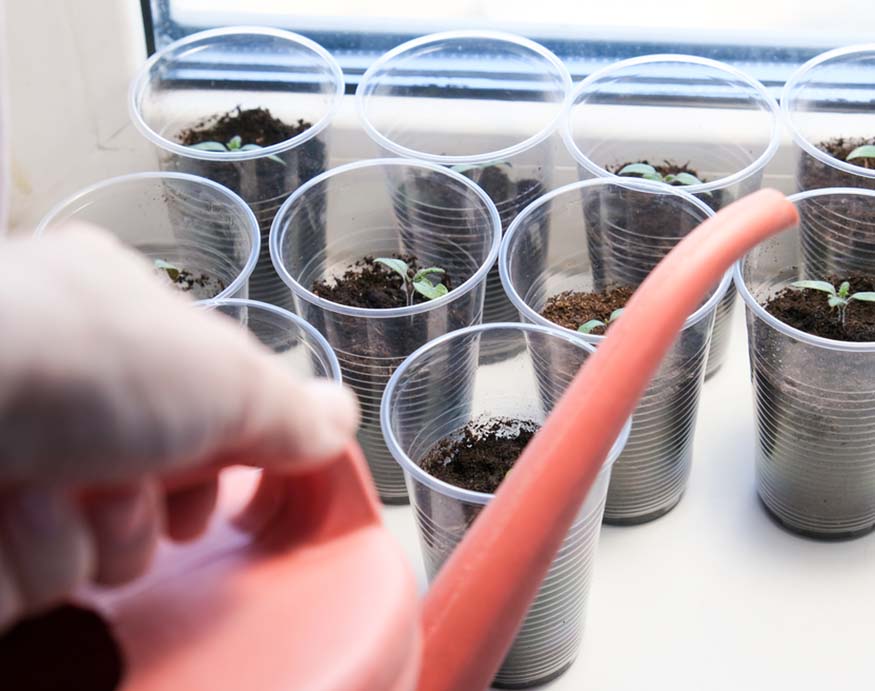
Keep the soil moist but not soggy. Be careful not to overwater. That can cause root rot and weaken the plant.
Tomatoes are heavy feeders. When planted in the ground they can send roots deep to find more nutrients. In a pot, where their roots are limited, fertilizing is a good idea. Use an organic liquid tomato fertilizer after the first month.
Air Circulation
Air circulation is an often-overlooked factor when growing tomatoes indoors. Your tomatoes need an artificial breeze for a couple of reasons.
Pollination
First of all, the wind is one of the primary ways tomato plants pollinate their flowers. Even more importantly, air circulation will prevent water from accumulating on the leaves of your tomato plants, which can put them at risk of fungal diseases and other problems.
Protection From Rot and Disease
There are several potential sources of dangerous dampness: moisture in the air, water that gets on the leaves during watering, or the plant’s own “sweat” from transpiration (which helps the plant absorb nutrients by replacing the exuded moisture with moisture from the soil). Regardless of the source, circulating air will help reduce this moisture and protect your plant from rot and disease.
Light
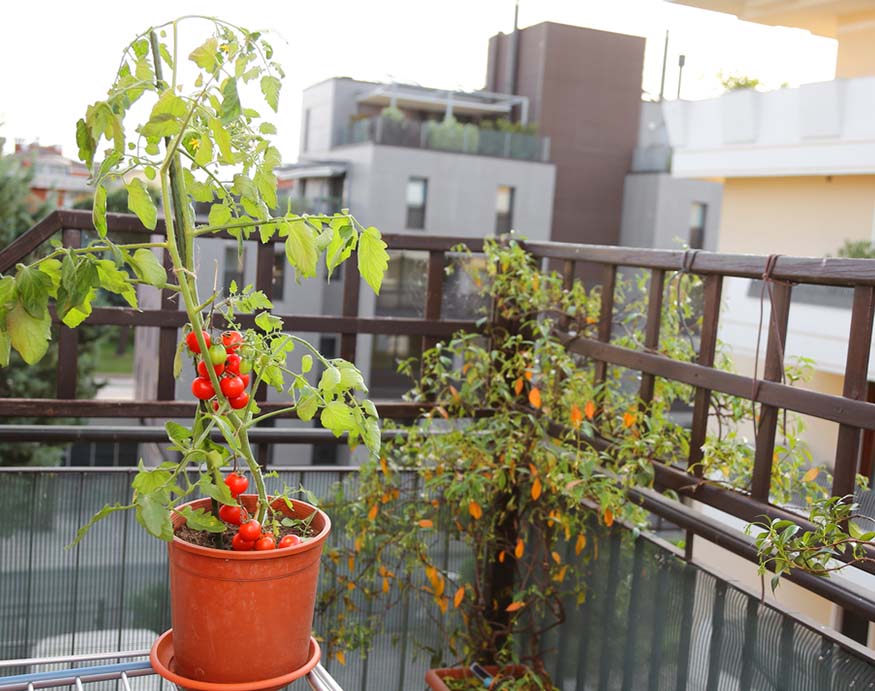
Tomatoes need bright direct light for at least eight hours per day.
Indoors, you can keep them under the grow light anywhere from 16 to 18 hours per day. It is best to keep the supplemental lighting on a timer so that your artificial sunrise and sunset are consistent.
If your plant gets a lot of unidirectional light, you should rotate your tomatoes 90 degrees daily. By doing so, you can ensure that each side receives equal sunlight. Of course, this is much easier with small determinate tomatoes than indeterminate plants.
Related Post: Try growing your tomatoes in an Aerodarden!
Pruning
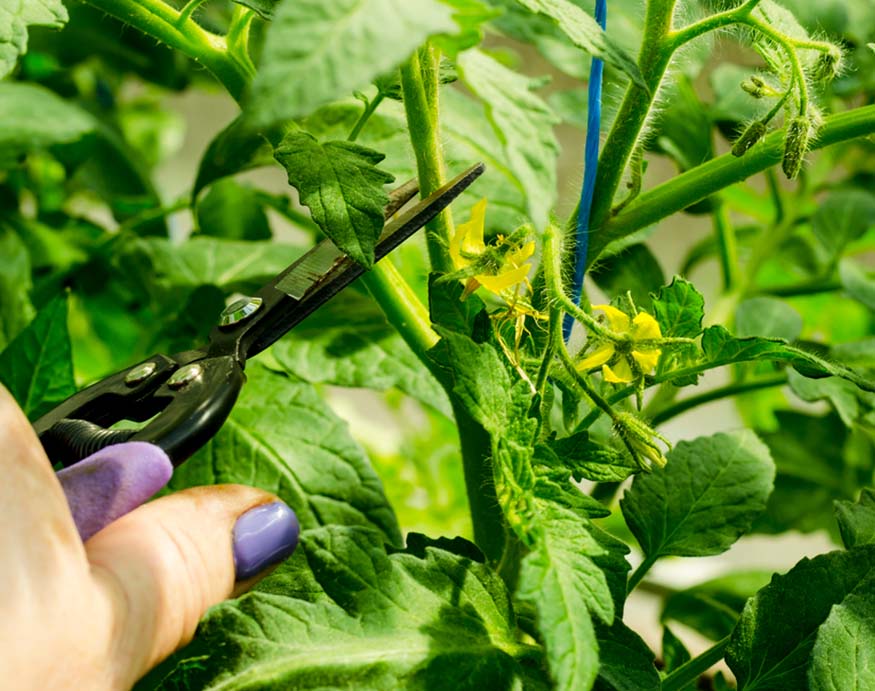
There is no need to prune dwarf or determinate tomato plants at all.
If you are growing indeterminate tomatoes indoors, pruning will be essential. Some people recommend removing all the suckers and keeping only the central growing vine. However, most plants are hardy enough to support a few vines, so for more production at a shorter height, you could leave two or three low suckers and remove the rest.
Each growing end of your indeterminate plant should be trained to grow up a tall, sturdy trellis. When your plants reach the limits of your trellising system, you can cut off the growing ends (“topping” the plant) with a good set of pruning shears. The plant will eventually die, but it will devote all of its remaining energy until it dies to ripen the fruit on the vine.
The Best Tomatoes To Grow Indoors
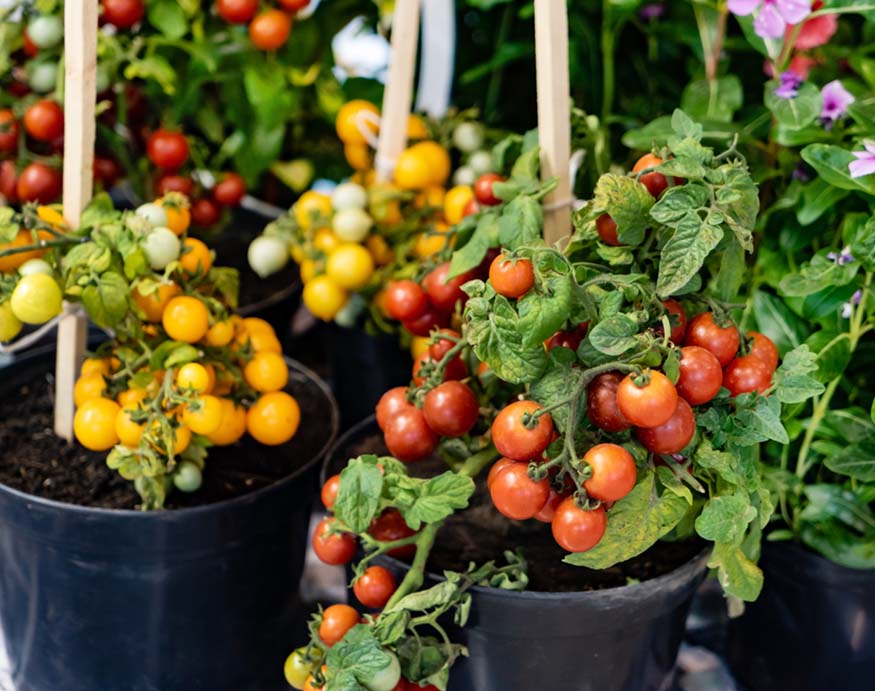
Although there are thousands of species of tomatoes in nature, all domesticated tomatoes are the same species, Solanum Lycopersicum. Selective breeding over the last several hundred years resulted in a wide variety in the size, color, and flavor of the fruit, shape, and the plant’s disease resistance, for example.
The tomatoes best suited to indoor life are cherry tomatoes. They have a shorter time from germination to maturity than bigger tomatoes. Because they do not get as heavy as large tomatoes, they are less likely to snap off weak or inadequately supported vines. However, you can grow small non-cherry tomatoes as well. Just stay away from beefsteaks or other large tomato varieties.
Growing tomatoes indoors is challenging, but it helps to grow a suitable variety for your indoor space.
Factors to Consider
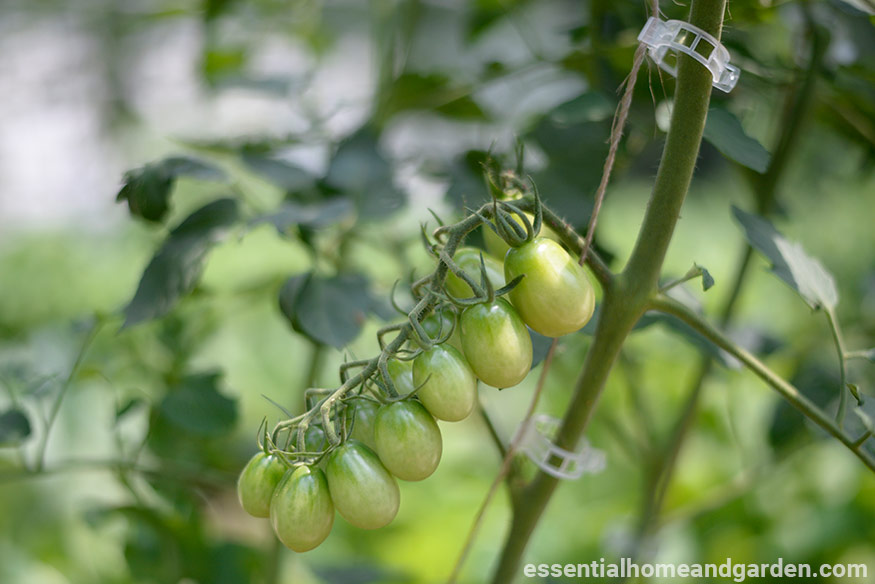
Many indeterminate tomatoes will grow to over ten feet in length. You will need elaborate structural support if you want to grow them indoors without topping them. On the other hand, determinate tomatoes need less support, and some dwarf varieties don’t need any.
Determinate tomatoes tend to produce ripe fruit in one or two big batches and then die off. In contrast, indeterminate tomatoes will continue producing new fruit as long as they are healthy and continue growing. That means if you want to grow the conveniently sized determinate tomatoes, and you want a fresh supply all winter, you need to succession-sow a new plant every couple of weeks.
Five Great Tomatoes to Grow Indoors
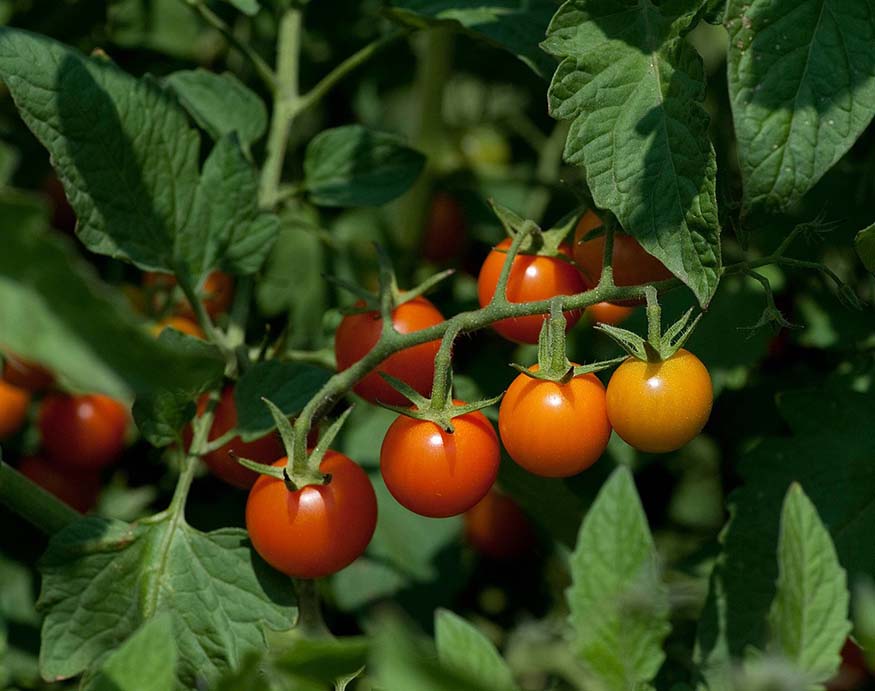
1. Smallest Determinate Indoor Tomato: Micro Tom
This tomato is truly itty-bitty, reaching only 6-8 inches at maturity. Despite its small stature, each plant will produce several dozen sweet little fruits. Their diminutive size makes them easy to grow in little pots or hanging baskets. You’ll have room for several of them even in a small window.
2. Best Tomato For Indoor Hanging Baskets: Red Robin
Red Robin is a tiny tomato plant, topping out about a foot tall, but don’t let that mislead you. A Red Robin will produce a surprisingly large yield of classic round red cherry tomatoes with good “real tomato” flavor (so they’re perfect for people who feel most cherry tomatoes don’t measure up). Red Robin is so small that it typically does not require support and is perfect for growing in a hanging basket.
3. Best All-Purpose Indoor Tomato: Patio
If you want to grow something a little bigger than cherry tomatoes, try Patio. This short determinate plant will only grow to about two feet tall. You can usually get away without staking it unless it sets a lot of fruit. Patio produces tasty medium to small tomatoes, but at 3-4oz, they are more suitable for sandwich slices than cherry tomatoes.
4. Lowest Maintenance Indoor Tomato: Oregon Spring
If you’re growing tomatoes on a windowsill, the Oregon Spring is a particularly great choice because it is tolerant of cool weather. It is not a dwarf plant but is determinate, meaning it tends to top out at only a couple of feet.
You won’t even have to worry about assisting with pollination because Oregon Spring is a self-fertilizing (parthenocarpic) tomato. The fruit is around 5oz, a nice size for slicing or cooking.
5. Best Indeterminate Indoor Tomato: Sungold
Many gardeners consider Sungold their all-time favorite tomato. It is incredibly productive, and the bright yellow cherry tomatoes are so good it’s hard to avoid eating them before you get to the kitchen.
Sungolds are tall, indeterminate plants, so they need a large pot and tall trellis. If it gets too tall for your trellis, you can top the plant (cut off the growing end or ends) to arrest its growth. After being topped, the vines will stop growing longer and stop putting on new fruit. The fruit that is already growing will continue to mature.
The Wrap Up
Growing tomatoes indoors is not for the faint of heart. Still, with sufficient investments in equipment, suitable plants, and time and attention, this quest is far from impossible.
With the tips in this guide and a little effort on your part, you’ll be savoring sweet cherry tomatoes straight off the vine at your next Christmas dinner.